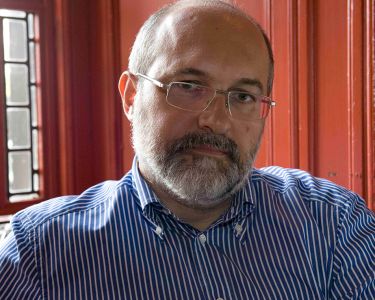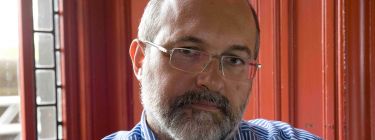
Renaissance by mistake
Prof. Pier Luigi Sacco, PhD, Professor of Cultural Economics at IULM University, Milan
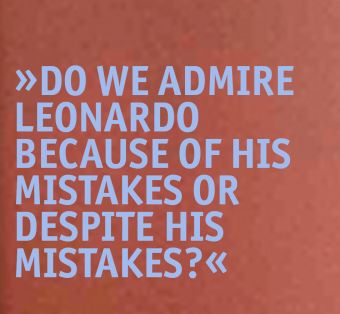
Renaissance by mistake
Spirit, are you there?
Leonardo da Vinci is probably the most acclaimed creative mind of all time and the epitome of the Renaissance man. His knowledge, talents, vision, and imagination spanned several disciplines that sadly now constitute different cultures: Science and Art. We admire Leonardo so much not only for what he did, but also and maybe even more for what he anticipated: in his notebooks, he figured out ideas and possibilities that would only become a reality several centuries later. And yet, if we think of it, most of what we admire Leonardo for did not work. His tank or his submarine, to cite a few famous examples, are brilliant intuitions, but nothing more. Even an artistic masterpiece like The last supper is in critical condition because Leonardo experimented with a new painting technique of his own invention, a tempera grassa, that would fail to stick properly to the humid wall. A detractor of his time would not have been in a difficult position in depicting Leonardo as a fraud by selectively picking a collection of such incidents. But his experimental, risk-taking attitude was a constant feature of his creative method. This raises an interesting question: Do we admire Leonardo because of his mistakes or despite his mistakes?
Mistakes and the Renaissance Men: then and now
We could be tempted to say, Neither one nor the other. We do not admire Leonardo because he did something wrong, but because he was visionary enough to imagine possibilities that were much beyond the technological standards of the time, and inevitably he could not get them right given the current state of knowledge. At the same time, blaming him for not getting them right would be totally unfair in view of the fact that actually working submarines or tanks would in the first place require engines that were inconceivable at the time of Leonardo. But can we really separate in any way Leonardo’s prodigious ingenuity from the ‘mistakes’ it produced? After all, most of Leonardo’s imagination of possibility comes from a careful and most insightful observation of nature: his machines are distillations of design principles found in animal bodies, and of reflections on the action and properties of natural forces. And like Leonardo’s, such evolved principles have in turn been built by nature on the basis of
constant trial and error, of endless refinement of mistakes: After all, what else are the copying glitches that cause genetic mutations?
In the constant lip service to Renaissance that is so much characteristic of our times—the idea of Renaissance has probably never been so popular as it is nowadays so that practically every day somebody calls for a ‘new Renaissance’ of some kind—we seem to have learnt this lesson in its iconic translation in the biographies and visions of those who are generally reputed and celebrated as the contemporary equivalents of the Renaissance man: self-made digital economy tycoons like Steve Jobs, Sergey Brin and Larry Page, or Elon Musk, all of whom have built their fortunes through a relentless toggling between moments of sheer defeat and utter triumph, with the former providing the lessons that paved the way to the latter. Samuel Beckett’s “Fail again. Fail better” quote has become the most famous inspirational quote of Silicon Valley culture (and it is difficult not to feel the irony of all this). We have understood how to make sense of mistakes and profit from them, after all.
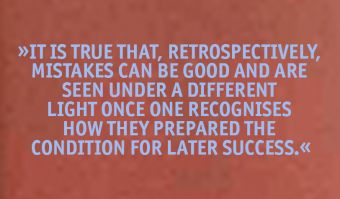
A culture of making mistakes is not a mistake in culture
But is this really the case? It is true that, retrospectively, mistakes can be good and are seen under a different light once one recognises how they prepared the condition for later success. But when mistakes are made, it is much more difficult to take them cheerfully, especially when one is moved by an enthusiasm and sense of possibility that clash with sudden, sometimes brutal denial. Being mistaken may sometimes sound like being treated unfairly in terms of lack of responsiveness to something that deserved more attention and consideration, and it really hurts. What is or is not a mistake does not depend only on objective conditions but may also reflect social circumstances. A good idea can become a mistake when it is proposed ahead of the time and is basically not understood by others—but is it then a fault to see things long before others do, as
Leonardo did? Or can it become a mistake because it conflicts so much with the incumbent vested interests that it becomes a threat that needs to be eradicated? To change a mistakenly good idea into a success, sometimes you do not need to change the idea, but the environment. And this is, ultimately, what the Renaissance largely did (to be fair, not in opposition to a supposed, previous Dark Age as it has been long contended, but through a seamless development of
long-baked previous ideas). It created a social milieu that was welcoming and favourable enough for creative minds that would have been out of place and out of context in most other societies, and whose ideas would have been refused as mistakes in different circumstances—as it would become clear a bit later in the gloomy times of the Counterreformation.
Todays Paradoxes trapping a Next Renaissance
So, the question becomes: Are we prepared to take the responsibility of what it means to invoke a new Renaissance? Are we prepared to set the context for good ideas not to sour into bad mistakes? The same society that celebrates Renaissance genius is keen to embrace an educational model in which only STEM disciplines matter (“Leonardo, stop wasting your time painting and try to make that damn plane fly!”). This same society seems to be willing to cut funds for basic research to reallocate them towards ‘useful’ applied research (“Leonardo, stop wasting your time with that tank thing and come up with a practical idea!”). It is easy to see how our current choices are turning into ‘mistakes’ the same attitudes that we retrospectively celebrate. Paradoxically, what attracts us to the idea of Renaissance genius is that we leave our trust to the creative vision as a way of maintaining our own need for assurance and risk-aversion (‘the genius will do it right, even if I do not understand how and why’). However, what makes it feasible is exactly the contrary: Responsibly embracing collective risk-taking is the only viable context for successful creative ideas.
So, what does a ‘new Renaissance’ mean today, concretely? It means being able to create a social attitude of openness toward the weird and the unfamiliar. Weird, unfamiliar things can be very irritating, and we are generally not very good at managing irritation. Truly new ideas are often refused not because they appear too complex, but because they appear too stupid—largely because we are not able to appreciate their real depth and complexity. Weird, unfamiliar things call for cognitive and emotional effort. But we live in a world in which we are much too keen to simplify things to people. And perhaps not accidentally we witness an unprecedented flourishing of spurious or entirely fabricated knowledge (‘conspiracy thinking’) whose only real appeal lies in its nodding to our need to understand the world through ideas and categories we are already familiar with and require no real learning or cognitive effort. We are often suspicious of anything that challenges our prejudices and intuitions.
Recovering the Renaissance spirit
The road to a ‘new Renaissance’ is long and tortuous, and it passes through an unprecedented mass flourishing. To turn mistakes into good ideas we need societies that are ready to venture into the unfamiliar with grit and curiosity, and that have the patience to absorb delusions and the generosity to overcome partisan thinking. But this sounds exactly like the opposite route to the one pursued by the business models of many of those digital giants who, ironically, we celebrate as the modern incarnations of the Renaissance spirit. These are businesses that profit from the increasing polarisation of the public opinion and from the formation of echo chambers that commodify people’s prejudices.
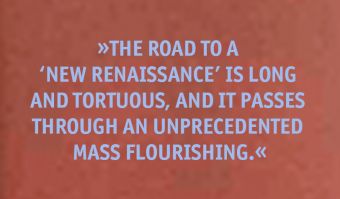
Recovering the Renaissance spirit is about turning the tide. Digital culture can become the platform for a new Renaissance if it does what the Renaissance once did: creating a social platform for an unprecedented form of collective intelligence. And Europe can play an important role in this process exactly because it does not have such an incumbent interest in the extraction of value from the status quo as is the case for the Silicon Valley giants. Europe can pursue different possibilities because it has much less to lose—and much more to gain. But to do so, we need to recover the true social dimension of the Renaissance whose locus is not the studio of the solitary genius, but the square: the centre of community life, the
theatre of exchanges and encounters. The Renaissance square is inclusive, it is a public space that everybody can inhabit as a peer, and it is pertinent that the square as the centre of human-scale community life is a typically European urban phenomenon.What is the public space that we may inhabit in our ‘new Renaissance’, and where is it? What are the conditions for access, and who controls them? What ensures that it is diverse and inclusive enough to welcome mistakes and turn them into good ideas? These are the questions that we need to credibly answer if we want to take a new Renaissance seriously. And not to do it would be a mistake—one that would be difficult to turn into a good idea under all circumstances.
Pier Luigi Sacco
Pier Luigi Sacco, PhD, is Senior Advisor to the OECD Center for Entrepreneurship, SMEs, Regions, and Cities, Associate Researcher at CNR-ISPC, Naples, and Professor of Economic Policy, University of Chieti-Pescara. He is also Senior Researcher at the metaLAB (at) Harvard. He has been Visiting Professor and Visiting Scholar at Harvard University, Faculty Associate at the Berkman-Klein Center for Internet and Society, Harvard University, and Special Adviser of the EU Commissioner to Education, Culture, Youth and Sport. He is a member of the scientific board of Europeana Foundation, Den Haag, of the Advisory Council on Scientific Innovation of the Czech Republic, Prague, of the EQ-Arts Foundation, Amsterdam, and of the Advisory Council of Creative Georgia, Tbilisi. He regularly gives courses and invited lectures in major universities worldwide, published about 200 papers on international peer-reviewed journal and edited books with major international publishers. He works and consults internationally in the fields of culture-led local development and is often invited as keynote speaker in major cultural policy conferences worldwide.
